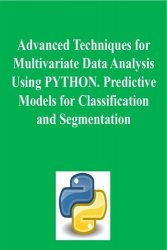Advanced Techniques for Multivariate Data Analysis Using Python. Predictive Models for Classification and Segmentation
- Добавил: literator
- Дата: 17-07-2025, 19:16
- Комментариев: 0
 Название: Advanced Techniques for Multivariate Data Analysis Using Python. Predictive Models for Classification and Segmentation
Название: Advanced Techniques for Multivariate Data Analysis Using Python. Predictive Models for Classification and SegmentationАвтор: César Pérez López
Издательство: Scientific Books
Год: 2025
Страниц: 410
Язык: английский
Формат: pdf, epub
Размер: 41.1 MB
This book develops multivariate predictive or dependency analysis techniques (supervised learning techniques in the modern language of Machine Learning) and more specifically classification techniques from a methodological point of view and from a practical point of view with applications through Python software. The following techniques are studied in depth: Generalised Linear Models (Logit, Probit, Count and others), Decision Trees, Discriminant Analysis, K-Nearest Neighbour (kNN), Support Vector Machine (SVM), Naive Bayes, Ensemble Methods (Bagging, Boosting, Voting, Stacking, Blending and Random Forest), Neural Networks, Multilayer Perceptron, Radial Basis Networks, Hopfield Networks, LSTM Networks, RNN Recurrent Networks, GRU Networks and Neural Networks for Time Series Prediction. These techniques are a fundamental support for the development of Artificial Intelligence.
Decision trees are a segmentation method, which tries to solve discrimination problems in a population by progressively segmenting the sample to finally obtain a reliable classification into homogeneous groups, according to the variable of interest called the segmentation variable. Decision trees are a predictive technique since the segmentation of the population is done according to the values of the variable of interest that plays the role of the dependent variable of the predictive model underlying the tree (qualitative variable). The assignment of a population element to a segment is done according to the values of certain variables measured on it that constitute the independent variables of the model (usually also qualitative variables, although quantitative variables with their values grouped in a small number of intervals are also often used). It is therefore a matter of selecting the explanatory variables that are most discriminating for the dependent variable and constructing a decision rule that allows a new individual to be assigned to a value or class of the dependent variable.
Random Forest is a powerful Machine Learning method based on the combination of multiple individual decision trees. In Python, you can implement random trees using the Scikit-learn library. We are going to build the tree in the example above using Random We start by loading the necessary libraries, importing the data, separating the independent and dependent variables and fitting the tree model using Python's.
The k-NN Neighbors or k-NN algorithm is a supervised learning algorithm used for both classification and regression. In classification, the algorithm assigns a class to a new instance according to the majority class among its k-nearest neighbours. In regression, the value of the new instance is the average of the values of its k-nearest neighbours. The k-nearest neighbours algorithm is a non-parametric supervised learning classifier, which uses proximity to make classifications or predictions about the clustering of an individual data point. While it can be used for regression or classification problems, it is generally used as a classification algorithm, based on the assumption that similar points can be found close to each other.
Скачать Advanced Techniques for Multivariate Data Analysis Using Python. Predictive Models for Classification and Segmentation
[related-news] [/related-news]
Внимание
Уважаемый посетитель, Вы зашли на сайт как незарегистрированный пользователь.
Мы рекомендуем Вам зарегистрироваться либо войти на сайт под своим именем.
Уважаемый посетитель, Вы зашли на сайт как незарегистрированный пользователь.
Мы рекомендуем Вам зарегистрироваться либо войти на сайт под своим именем.
